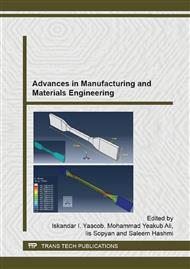p.361
p.369
p.373
p.378
p.382
p.386
p.390
p.394
p.398
Effect of Nanofiller on Flexing Mechanism of HDPE/EPR Nanocomposite for Sport Shoe Sole Application
Abstract:
For this decade, nanocomposite has received huge interest from over a thousand of researchers due to its outstanding properties in wide applications. Nanocomposite of sole shoes has become new development in sport shoes application while no interest from others has been reported. The purpose of this study is mainly to produce prototype and characterize flexing mechanism of nanocomposite outsole. The materials used for the outsole protoype were polymer matrix of high density polyethylene (HDPE) and ethylene propylene rubber (EPR) at ratio of 70:30 by wt% was added by 3 wt% of CNT nanofiller. The HDPE/EPR-CNT nanocomposites were prepared via single melt blending by using internal mixer and then compression moulded into outsole shape. The outsole was then gone through electron beam (EB) radiation at 100 kGy/s. The flexibility of unradiated and radiated nanocomposite outsole were tested by flexing test according to SATRA TM161 and ISO-17707 standard and fractography of the nanocomposite outsole was observed visually. EB radiated nanocomposite show high properties which suggesting that greater count number in flexing test and less void was observed compared to the unradiated nanocomposite.
Info:
Periodical:
Pages:
382-385
Citation:
Online since:
July 2015
Keywords:
Price:
Сopyright:
© 2015 Trans Tech Publications Ltd. All Rights Reserved
Share:
Citation:


